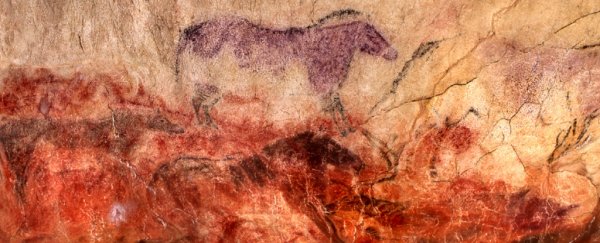In some of the earliest cave drawings ever found, the mighty horse reigns supreme over all other animals. Depicted with precision and gusto, this majestic creature is hard to miss.
In fact, for every four animals drawn upon the cave wall in Stone Age France and Spain, at least one is bound to be a horse. Usually larger than all the others, this powerful animal will often feature above lions, rhinos, mammoths, bison, and bears.
That wouldn't be strange if these ancestors were using horses for transport or as a main food source.
But these images were drawn thousands of years before humans domesticated and started riding horses, and as the authors note, reindeer was their staple meat, not horse.
Still, it's obvious that horses meant something special to the people of Stone Age Europe, but exactly what, no one can say for sure.
Georges Sauvet, an expert in prehistoric art, has collected more than 4,700 examples of Palaeolithic drawings, paintings and engravings in the hopes of finding out more.
The figurative representations are anywhere from 12,000 to 30,000 years old, originating in what is today France and Spain."
As the years went by and the images piled up, he couldn't help but notice "the primacy of the horse".
Using several statistical analyses, Sauvet shows that horses are portrayed in a noticeably special way in ancient European art. Nearly 30 percent of all the animals in his collection are horses, and more than three quarters of the sites included at least one image of the animal.
While horses and bison together dominate the record, making up roughly half the animals depicted, the former appears to have a special status. It is found in 44 percent of the panels, and is much more consistently featured than the bison.
"The regional variations that we observe are mainly stylistic and thematic," writes Sauvet, who works at the University of Toulouse-Jean Jaurès in France.
"Even the higher number of hind depictions in the Cantabrian region or the "preference" for mammoth depictions in the Périgord do not undermine the primacy of the horse as the preferred subject."
One of the give-aways, he argues, is the direction the horses are facing. While most animals are drawn oriented to the left, horses are the only species that is predominantly oriented to the right.
Claude Barrière had noticed this in 1997, but his revelation went without much notice. Now, Sauvet says his findings confirm Barrière's suspicion.
"The preeminent role of horse is exemplified by strong and salient achievements, and the artists were very attentive to this point," Sauvet argues.
"They chose remarkable locations, at high and visible places to draw large horses. It is as if the choice of spectacular locations served to symbolically signify that horse was "on the top", above the other species."
A 2.70 m-long horse drawn on the great ceiling of the Rouffignac cave in Dordogne in southwest France is probably the largest horse in Paleolithic cave art history. Underneath it is a ring of bison, ibsex, mammoth, and rhinos.
Drawing an animal with perfect proportions on the wall or ceiling of a cave is quite the feat, and according to Sauvet, the images of horses are particularly accurate in form, dimensions and situation.
In fact, a study in 2012 found that prehistoric humans were better at drawing horses than modern artists.
April Nowell at the University of Victoria in Canada told New Scientist that archaeologists have noticed the horse's prominence before. But she says that while this study certainly adds to that pattern, we can't make any real inferences about why.
Sauvet argues that rock art is linked to mythical stories, and, therefore, horses might have been some sort of mythical status. Nowell says that's taking it too far. In the end, they both agree, there's something about the horse.
The study was published in the Journal of Archaeological Science: Reports.
